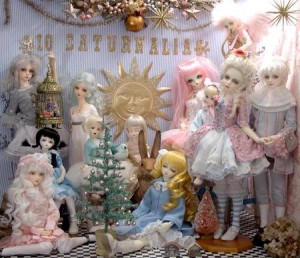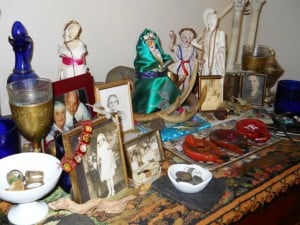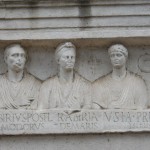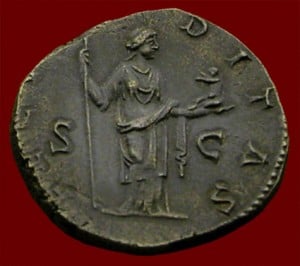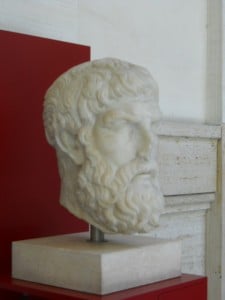Io Saturnalia! Io Triumphi! Io Saturnalia!
The Virgin returns, returns old Saturn’s reign,
With a new breed of men sent down from Heaven.
~ Virgil, Eclogue IV
On a cold, crisp night, half past midnight on 17 December, the leading star of Virgo rises above due East on the horizon. This year the virgin Astraea, the Maid of Justice, shall be proceeded (by roughly 45 minutes) by the planet Mars. Her leading star, called Zavijava today, Beta Virgonis was known as the Star of Janus that ushers in the festival of Saturnalia.
Saturnalia is one of the most festive and most popular festivals among cultores Deorum today. It celebrates the Golden Age when good King Saturnus ruled in peace, with Justice and Harmony, with His children Janus, Hymns, Fortune, and Happiness. Mankind did not have to toil or farm, as the land was so bountiful that one need only reach out to pluck your meal. Grapes grew so plump that they make wine by simply falling to the ground when they became ripe. No one mined the earth, no gold was hoarded, no greed was felt, no crime committed, no wars disturbed anyone’s thought. The Gods walked among the children of the earth, sat down at their tables for feasts, toasted one another with mulled wine and honeyed drink. Saturn’s time of harmony and peace is relived over Saturnalia, 17 – 23 December.
From my childhood, and then from the childhood of my sons as well, I have always associated the season of Saturnalia with merriment, good food, friends, family and, in my family, mounds and mounds of cookies. Over the course of seven days a series of feasts are held, extended further then as we celebrate Christmas and New Year’s with additional friends and family. That is, my wife’s family. Being that my wife is a Catholic, this time of year brought up some fun situations when our sons were young. First, before Saturnalia, one has to make all those cookies. After all, we have seven days to celebrate, not one, by giving out little presents and lots of cookies. Sometimes I would begin making cookies in October, to allow certain types of cookies to ferment in tins for a while. Wine cookies, rum balls, whiskey balls, and then some of the decorative cookies as well.
There are two types of cookies that I make for the winter and spring holidays. One is a braided anise cookie, the Knot of Hercules as we call it, that represents the bride’s girdle, which in turn is a symbol of her virginity. Ergo, Virgo. The other are phallic cookies. As one myth has it, Ouranus was so taken with his wife, Mother Earth, that He would not withdraw from Her after intercourse. This caused Gaia more than a little problem as She kept getting pregnant but was kept from delivering Her children. That is until one day one of Gaia’s children, Saturn, dismembered Ouranus. Something like the myth of Isis, I suppose, where She re-assembled the dismembered body of Osiris, but finding one part still missing, She had to bake a phallic cookie for Him in order to conceive Horus. Virgin brides and erect phallics, yin and yang, the harmony in Nature seen as a balance between female and male forces, water and fire, even and odd, condensed down into our cookies. There was one year that I especially remember when my sons and I were making the phallic cookies together. We decided to make an extra large phallic cookie for my wife. We slathered on green icing and then the boys thickly covered it in candy sprinkles. Just as they finished, there came an unexpected knock at our door. Standing there was one of my Christians in-laws along with his young son and daughter. My boys were so proud of the cookies they made that they snatched them up and push into the faces of their cousins. Seeing them, my brother-in-law quickly wrapped his hands around his children’s eyes and marched them out of the house.
Well, being in a mixed household did have its fun moments, mostly for me and my sons. Not as much for my Catholic-school-girl wife. But then, being from a pagan tradition, we are not exclusionary as are some religions. The house would be decorated with two very large menorahs – a friend’s gift that had come from a synagogue. We had wreaths of pine, with white ribbons and red candles for Saturnalia. And there was a Christmas tree of sorts, decorated by all of us with dough figurines of Gods and Goddesses, maniae, Santa, Snoopy, manger scenes, and magi, a Good Shepherd figure, along with Venus and Adonis beneath the tree, and a crescent and star above. As in other families, our holiday traditions were layered over in memories, only ours did not arrive from any single religious tradition.
My fun would begin on the night before Saturnalia. I would steal away my sons’ shoes and place then outside in the cold after slipping chocolate candy bars into them. At first there was the confusion of being unable to find their shoes, before remembering where they ought to look. In later years they would come to place out their shoes by themselves, suffering cold feet if need be for some chocolate. Still, the nights are long and clear at this time of year, and although cold, a joy to observe the stars. Beginning with midnight, marked by the rise of Virgo, the first day of Saturnalia is all about religious ceremonies. In the early morning before dawn respect is paid first to our ancestors. The stars themselves, and the planets, are greeted as images of the Gods and the heavenly Lares. Wreaths and libations of wine are brought to the altars under the stars, for the Lemures and Lares Viales at the crossroad, for the Manes, for the Lares compitales at the boundary stone of our property, and poured over a large stone left by the glaciers that now serves as an altar for geni locii of the land. Since Saturnalia celebrates a new era, each year there is another little ceremony held as though it is New Year’s; the first New Year’s, really, as another is celebrated on the first of March rather than the first day of January. The first person to enter the front door therefore heralds in what the year to come shall bring. And so, while leaving through the back door, going around to place my sons’ shoes by the front door, I also carried an offering tray of salt, coins, candles, flour and other gifts. Rapping at the front door, often to my wife’s surprise, I am let in with gifts which represent good health, prosperity, warmth, happiness, food and sweet things for our household in the next year. The tray is set on a table at the center of the house and celebratory drinks are had before going off to bed. Dawn will then bring another round of religious ceremonies, this time for the celestial Gods, beginning with Janus, to start off the festival week.
More fun for me, in the form of playful tension with my wife, came as the week progressed. I would hide sweets and toys in my sons’ clothes, coats, or book bags, a little something to find each day, even while my wife kept insisting that presents had to wait until Christmas day, which just never happened for us. There was Saturnalia, followed by winter solstice, and then Christmas Eve before we ever got to Christmas day. In the same way, I shall be sharing some of our traditions, both ancient and modern, over the course of the next couple of weeks as we make our last preparations for Saturnalia and also celebrate some other holidays along the way.
Io Saturnalia! Io Triumphi! Io Saturnalia!

